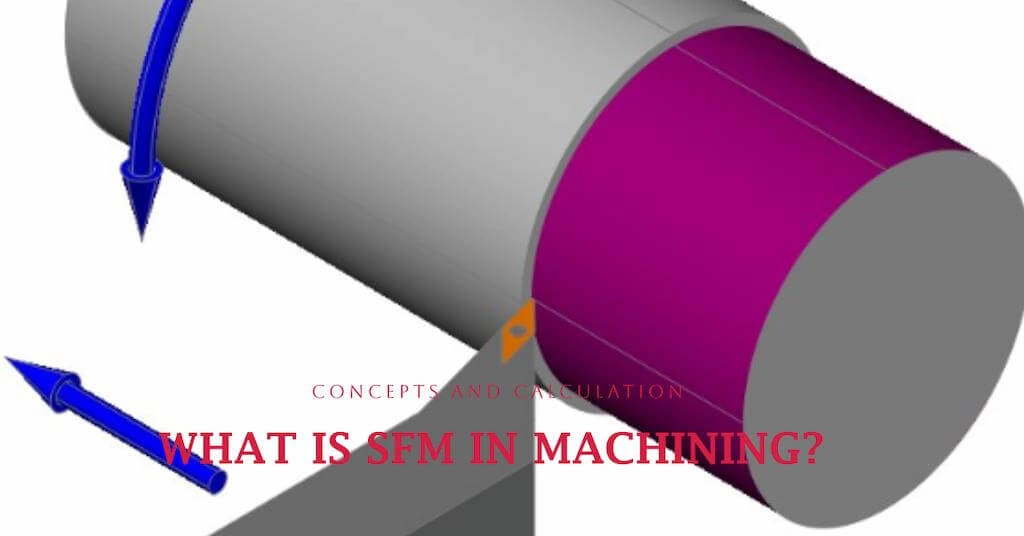
Surface Feet Per Minute (SFM) tells the machine about the material removal rate from the work surface, quick or slow. CNC operators and engineers also recognized this term as the spindle head’s speed, which means how quickly teeth form the chips for shaping the workpiece.
The CNC SFM parameter is also expressed in the form of millimeters known as surface millimeters per minute or SMM. Calculation and optimization of SMM or SFM in machining is essential for fast and accurate manufacturing.
Furthermore, we will discuss the concept, calculation, and why SFM is so important in CNC machining operations.
Are Cutting Speed and SFM the Same Parameters?
Both cutting speed and SFM in machining broadly deal with the same thing, but mathematically they are not exactly the same. They specify the material removal speed: SFM calculates in terms of the speed at which the cutting edge of the tool travels across the surface of the workpiece, whereas cutting speed is the rate at which the cutting tool moves through the material( inches/minute or meter/minute).
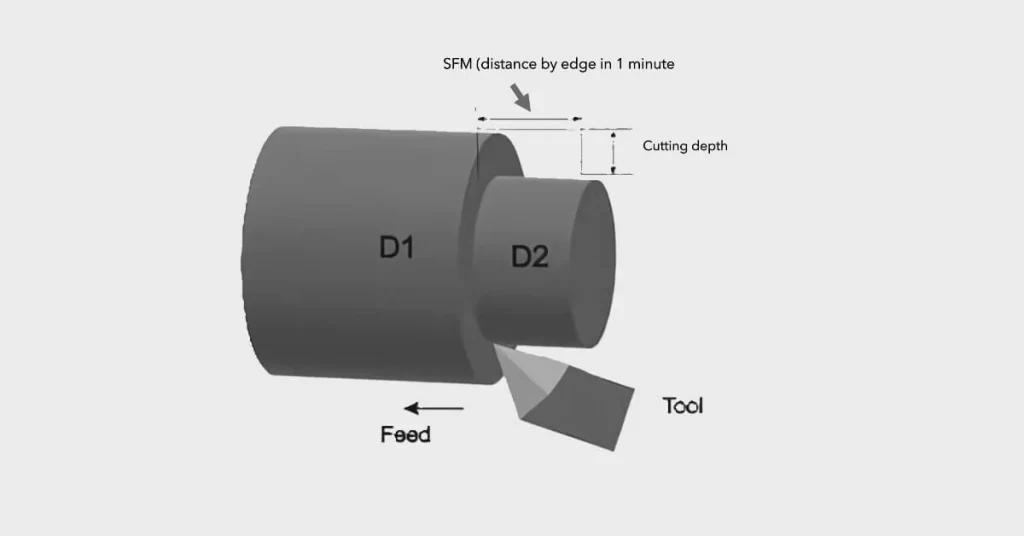
A schematic diagram of the SFM concept
Moreover, SFM in machining provides clear information regarding the optimal cutting speed for any CNC machining process. Engineers and operators rely on SFM to find the best spindle RPM based on machining characteristics and work material.
Converting SFM to RPM
In CNC machining, SFM and RPM are interrelated terms. The surface feet per meter values can be converted into spindle RPM (the speed at which the moving tool or work rotates) by a mathematical expression;
RPM= SFM/ (Cutter Diameter x π)
Or, SFM= RPM x cutter diameter x π
(Note: Here, the cutter diameter is in the feet unit. If it is in inches you need to divide the cutter diameter by 12.)
Furthermore, we can see from this relationship between SFM to RPM that cutter diameter is the main factor that defines the expression.
Try Prolean Now!
What is SFM in Machining?
SFM is calculated in the CNC machine based on the provided tool travel inputs. This parameter describes how much of unit feet are being or will be machined in one minute. Since the diameter of the rotating element( either tool or workpiece) also influences the machining process, SFM accommodates the rotating diameter during the calculation.
It might be confusing if a machine needs to execute multiple CNC operations in a single workpiece. The use of tool variations makes SFM more difficult to calculate because you need to consider which CNC processes and toolings are used for this.
How to Calculate Surface Feet Per Minute in Machining Processes?
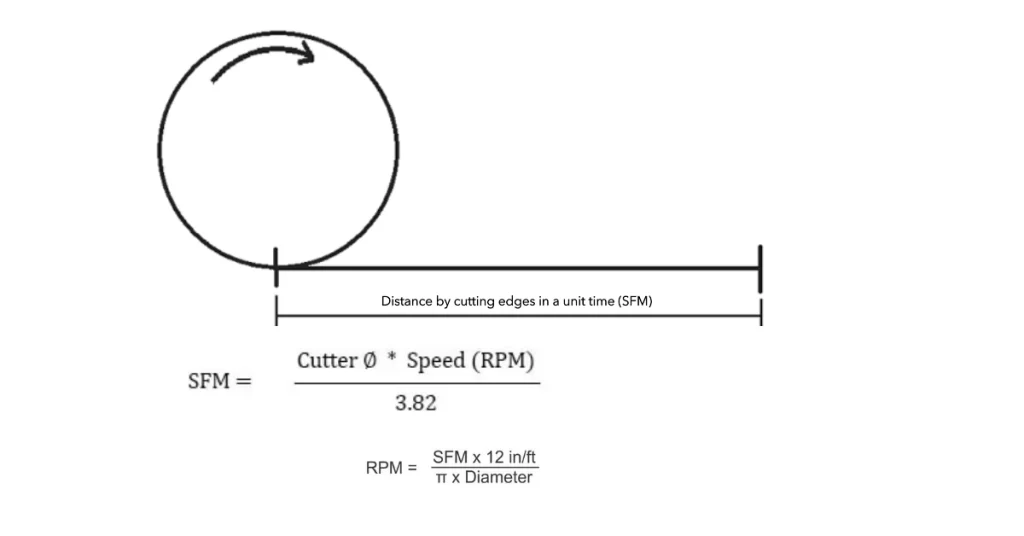
Calculation of SFM in machining
The fundamental formula to calculate CNC SFM value is its relation with RPM and cutting tool diameter, no matter whether you are using a lathe, milling, routing, or any other processes.
The main point is that you need to identify the secondary parameters, RPM and Cutter Diameter(D) first. Then you can calculate with the following equation;
Surface Feet Per Minute (SFM) = (RPM x cutter diameter x π)/12 inches ( if ⌀ is in inches)
This SFM value can be converted into surface meters per minute and surface millimeters per minute.
The table below shows, how you can convert SFM into other units and vice-versa;
| Convert From | To | Formula |
| SFM (ft/min) | mm/min | mm/min = SFM × 304.8 |
| SFM (ft/min) | m/min | m/min = SFM × 0.3048 |
| mm/min | SFM (ft/min) | SFM = mm/min ÷ 304.8 |
| m/min | SFM (ft/min) | SFM = m/min ÷ 0.3048 |
| mm/min | m/min | m/min = mm/min ÷ 1000 |
| m/min | mm/min | mm/min = m/min × 1000 |
Example of CNC SFM Calculation
Let’s take an example; calculation of CNC milling with a Spindle speed of 2000 RPM and End mill of 0.5” diameter;
Now, SFM = RPM x Cutter Dia. x π / 12 ( 1ft=12 “ as a “ /ft” factor)
= (2000 x 0.5” x 3.14)/12
= 261.67 feet per minute
So, the cutting head speed or SFM for this machining process is 261.67 ft/minute. If you need to further convert this into meters/ minute, SFM × 0.3048 = 79.75 ~ 80 meters/ minute.
Furthermore, you can download “The Excel Sheet for SFM calculation” here, it has a formatted structure to take your input and provides corresponding SFMs.
Importance of SFM in CNC Machining
The SFM in CNC machining directs how fast the cutter edges will move on the work surface, so it directly influences the removal rate, CNC machining tolerance, finishing quality, friction & heat generation, and tool wear. Both too slow or too high SFM values affect your machining result.
Counter the Heat-Build Up
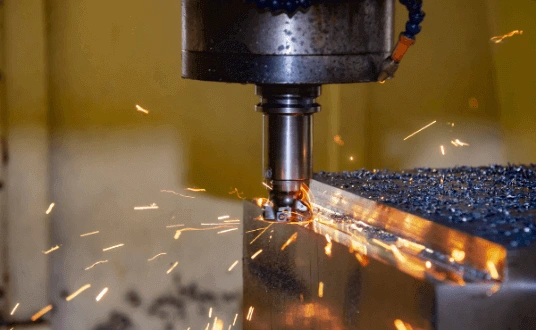
Heating of CNC tool due to excessive friction
If the CNC SFM is too high, the cutter’s tooth engages with material and forms chips rapidly, but the issue is heat generation. The high friction of the cutter and work surface generates more heat and increases the heat buildup in the machining areas. So, optimal SFM provides the best machining speed.
Tool Life
Without the optimized SFM for any machining operation, the tools tend to become duller over time and require frequent tool replacement for CNC precision machining. Additionally, the high speeds also cause rapid tool wear.
Surface Finished Quality
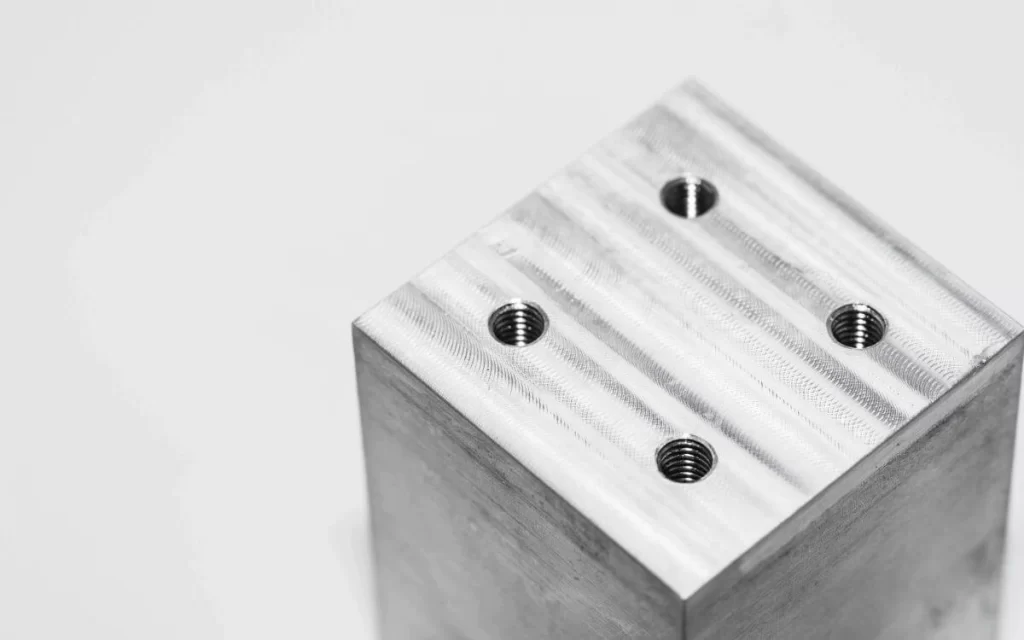
CNC as machined finish
Both too low and high SFM in machining are bad for the as-machined surface finish. Low speeds rub the cutter edges on the workpiece and high speeds, whereas high speeds tend to produce rougher surfaces.
Machining Efficiency
Using optimal SFM based on material type and tooling maximizes the machining efficiency due to efficient material removal.
How Workpiece Material Affect the SFM?
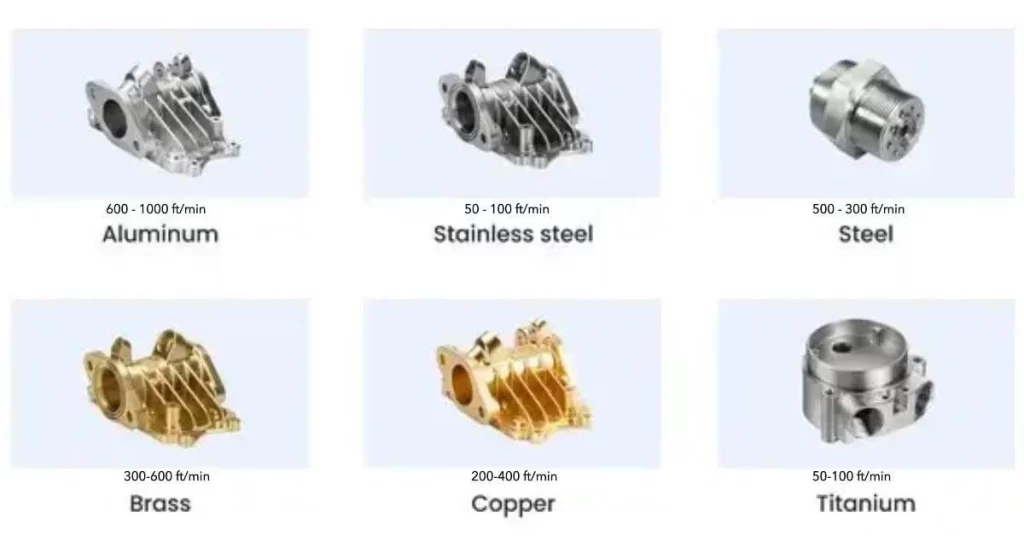
Recommended SFM and CNC materials
The SFM values are also different from one material type to another. This is because of the different RPM speeds based on the work material. Soft and high-machinability materials like aluminum have higher SFM values, whereas it continuously decreases for the tougher materials.
The table below shows the typical SFM range for some common CNC machining materials;
| Material | Recommended SFM |
| Aluminum | 600 – 1000 ft/min |
| Brass | 300 – 600 ft/min |
| Copper | 200 – 400 ft/min |
| Plastic | 300 – 600 ft/min |
| Titanium | 50 – 100 ft/min |
| Stainless Steel | 50 – 100 ft/min |
| Cast Iron | 50 – 150 ft/min |
| Tool Steel | 30 – 50 ft/min |
Milling SFM Chart
A milling SFM chart is a tool or systematic table the operator uses to choose the right SFM value based on work materials and cutter size.
Below is a typical Milling SFM chart, illustrating the ft/min corresponding to the corresponding end mill size.
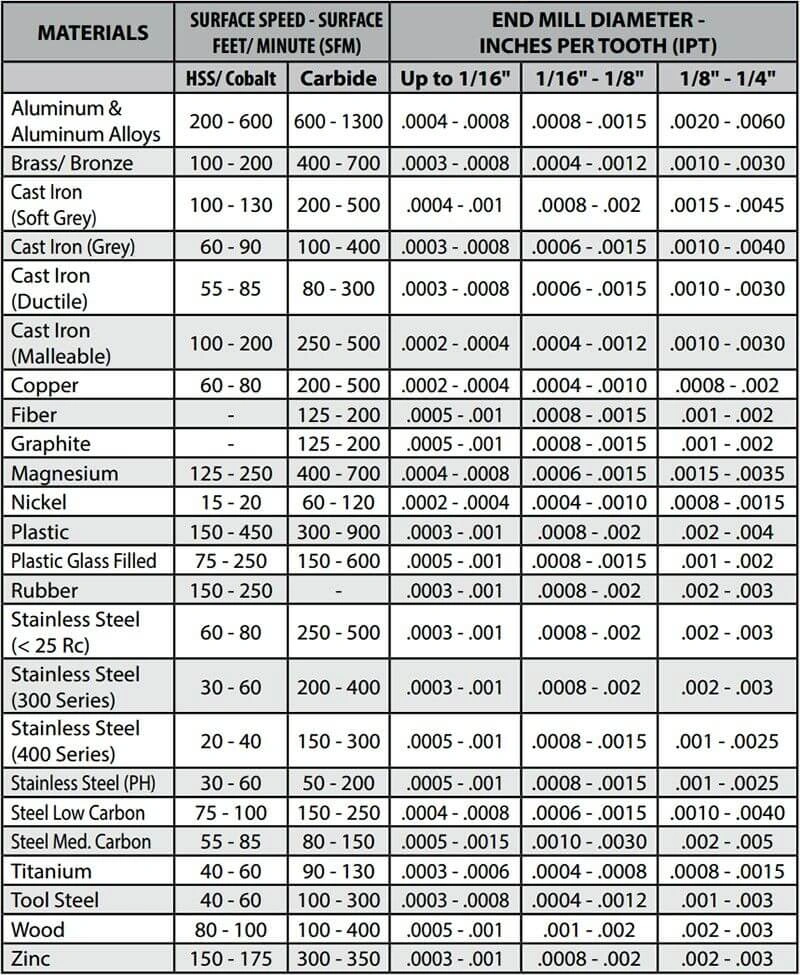
SFM milling chart
How to Use a Milling SFM Chart?
- Determine your work material type and identify it from the first column of the chart.
- Select your cutter material ( HSS, carbide, cobalt, etc) and the feed ( 1/16″, 1/18″ inches/tooth, and so on) for the operation.
- Choose a spindle RPM, which is most suitable for your CNC operation.
- Now based on the above identification, look for the corresponding SFM value.
Read more: Bevel Machining
Try Prolean Now!
Summing Up
Overall, SFM in machining provides optimal Spindle RPMs for material removal in milling, turning, tapping, etc. It helps operators and engineers create precise parts without compromising the tool life and machining speed. Additionally, it also determines surface roughness level and heat generation.
If you are looking to machine your part’s design and are not sure about the SFM and cutting speed, our industry engineers can help you. We have been in the field of CNC manufacturing for over a decade providing Machining Services for diverse industries worldwide.
We care about converting your design to CNC G and M codes precisely and the use of optimal CNC variables, including SFM. So, the machined parts will be exactly according to the designed specifications and end requirements.
FAQs
Is the Feed rate the same as the SFM in machining?
Feed rate measures the distance the tool advances in one rotation or unit of time. On the other hand, SFM is the linear speed at which the teeth’s edges contact the workpiece surface.
What is the difference between SFM and Spindle RPM?
Instead of rotational speed, SFM is about the cutting surface across the workpiece.
How can I convert SFM to RPM?
You can convert or calculate SFM by using the mathematical relation between SDM and RPM,
Is SFM different for Turning and Milling?
Yes, SFM varies between turning and milling due to tool movement and material engagement differences.

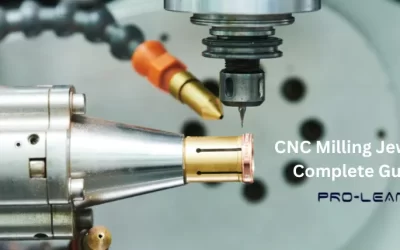
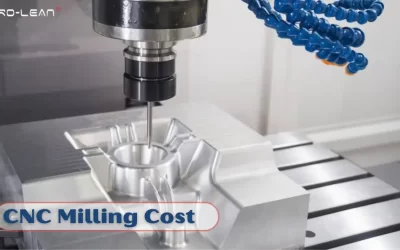
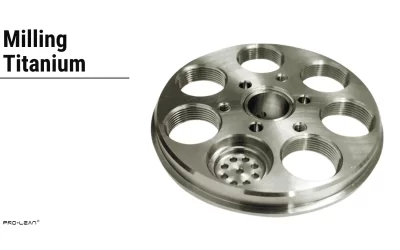
0 Comments